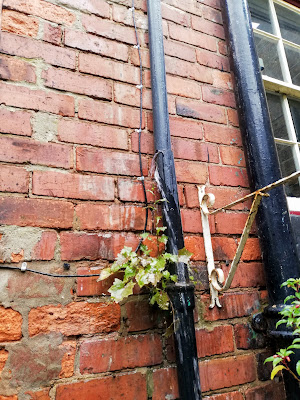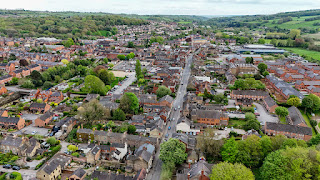Repairing the Gate
I'm currently working to repair our garden gate at the Old Post Office. It is quite old, but in no way is it the original gate. As suggested by the Council, rather than replace the gate we're going to remove the rotten wood at the base of the gate and scarf in some replacement planks. If we were to replace the gate, we'd need to seek listed building planning consent as the gate and the wall is part of the Grade II listing.
When the gate was built everything was measured in feet and inches so it is not possible to buy timber the same size as the original. So, I've bought oversize timber and I'm cutting and planing it down to the original Imperial measurements. The existing planks are tongue and groove jointed, so using my wood router, and a matched pair of USA produced Router bits, I've also cut tongue and groove joints in the new wood to the same dimensions as the old ones. We'll have to align the new planks (12"x5"x1") to line up with old planks and their irregular gaps. To avoid rust stains (*1) we'll use hidden stainless steel screws to mount the new planks on the old frame. We'll be using epoxy resin glue, filled with fibre and copper dust to join the old and new wood.
The vertical strakes of the gate have moved apart unevenly during the life of the gate. We'll be carefully aligning the new planks with the old during the repair. Once the gate has been re-sanded and painted the repair to the wood should be invisible.
Over the years, the height of the street footpath outside the gate has risen about 20 cms from the original level, but the gate was not adjusted for the change. As a consequence, leaves and debris accumulates in the gap between the gate and raised pavement. These damp conditions have caused the wood to rot. I'm going to add a thin sheet (0.7mm) of copper as a "tingle" at the repaired base of the gate to prevent further rot. This work avoids substantially the dimensions of the gate. We've sourced some copper nails (annular rings), to be used for securing the copper sheet tingle. If we used other metals for the nails it would be an invitation for corrosion from the winter road salt spray. We were able to source the copper sheet (Type C106) from a local Derby firm (Alloy Stock Ltd).
The top of the gate planks have also deteriorated, so we'll harden the wood and add bespoke milled wood cap bar across the top of the gate to replace the old one which has rotted away.
Once the repairs are complete we'll first chemically harden (Toupret) any remaining softened wood. We'll then use a copper epoxy resin filler to fill cracks in the wood surface. The gaps between the vertical tongue and groove boards fill be filled with flexible acrylic caulk. Next, we'll paint the gate with aluminium wood primer. Once the primer is dry, we'll coat the gate with two coats each of Teamac Marine gloss undercoat and topcoat paints according to our new colour scheme (Pigeon Blue RAL5014 and Papyrus White RAL9018).
Ironwork on the gate will be cleaned back to bare metal and repainted with black Hammerite anti-rust paint.
Note
*1: Steel wood screws were used in the construction of the current gate, these are showing through as rust stains. As part of the repair, we'll treat the "original" screws with rust convertor fluid before repainting.
The steel wood screws in the construction suggest the gate is less than 50 years old. Other clues in the stone work point to a different type of gate latch on the original Georgian gate, it was probably a wooden slide bolt.
When the gate was built everything was measured in feet and inches so it is not possible to buy timber the same size as the original. So, I've bought oversize timber and I'm cutting and planing it down to the original Imperial measurements. The existing planks are tongue and groove jointed, so using my wood router, and a matched pair of USA produced Router bits, I've also cut tongue and groove joints in the new wood to the same dimensions as the old ones. We'll have to align the new planks (12"x5"x1") to line up with old planks and their irregular gaps. To avoid rust stains (*1) we'll use hidden stainless steel screws to mount the new planks on the old frame. We'll be using epoxy resin glue, filled with fibre and copper dust to join the old and new wood.
The vertical strakes of the gate have moved apart unevenly during the life of the gate. We'll be carefully aligning the new planks with the old during the repair. Once the gate has been re-sanded and painted the repair to the wood should be invisible.
Over the years, the height of the street footpath outside the gate has risen about 20 cms from the original level, but the gate was not adjusted for the change. As a consequence, leaves and debris accumulates in the gap between the gate and raised pavement. These damp conditions have caused the wood to rot. I'm going to add a thin sheet (0.7mm) of copper as a "tingle" at the repaired base of the gate to prevent further rot. This work avoids substantially the dimensions of the gate. We've sourced some copper nails (annular rings), to be used for securing the copper sheet tingle. If we used other metals for the nails it would be an invitation for corrosion from the winter road salt spray. We were able to source the copper sheet (Type C106) from a local Derby firm (Alloy Stock Ltd).
The top of the gate planks have also deteriorated, so we'll harden the wood and add bespoke milled wood cap bar across the top of the gate to replace the old one which has rotted away.
Once the repairs are complete we'll first chemically harden (Toupret) any remaining softened wood. We'll then use a copper epoxy resin filler to fill cracks in the wood surface. The gaps between the vertical tongue and groove boards fill be filled with flexible acrylic caulk. Next, we'll paint the gate with aluminium wood primer. Once the primer is dry, we'll coat the gate with two coats each of Teamac Marine gloss undercoat and topcoat paints according to our new colour scheme (Pigeon Blue RAL5014 and Papyrus White RAL9018).
Ironwork on the gate will be cleaned back to bare metal and repainted with black Hammerite anti-rust paint.
Note
*1: Steel wood screws were used in the construction of the current gate, these are showing through as rust stains. As part of the repair, we'll treat the "original" screws with rust convertor fluid before repainting.
The steel wood screws in the construction suggest the gate is less than 50 years old. Other clues in the stone work point to a different type of gate latch on the original Georgian gate, it was probably a wooden slide bolt.


Comments
Post a Comment
We automatically delete any SPAM comments. All comments are subject to moderation before publishing. Any SPAM is individually reported to Google as such, this reduces the offending site's Google Ranking.